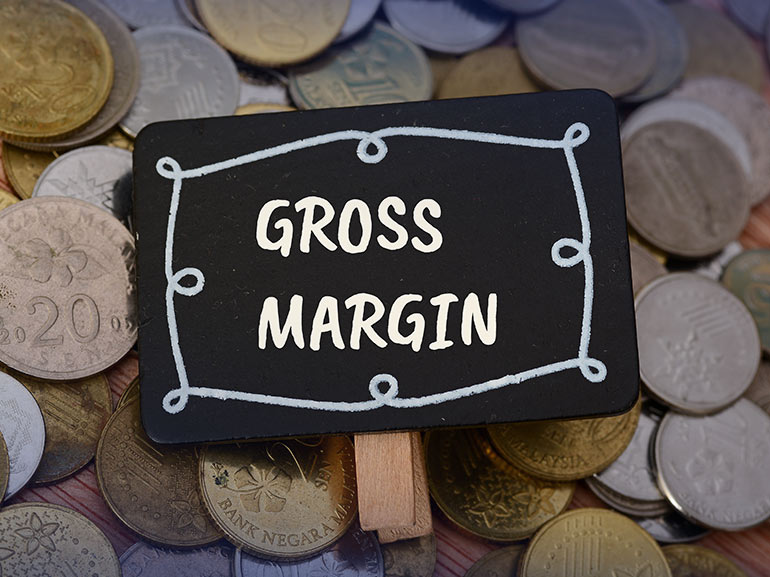Gross Margin Explained: What It Is & Why It Matters
Gross margin is one of the most critical financial metrics for evaluating a company's profitability and operational efficiency. Whether you're analysing potential stock investments or assessing business performance, understanding gross margin provides essential insights into how effectively a company converts revenue into profit after covering direct production costs.
In this comprehensive guide, we'll explain what gross margin is, how to calculate it using the gross margin formula, and why this metric matters for investors, traders, and businesses alike.

TL;DR
Gross margin, or gross profit margin, represents the percentage of revenue left after subtracting direct expenses like production and labour costs.
The formula is: Gross Margin = ((Net Sales - COGS) / Net Sales) × 100
Gross margin reveals a company's financial health, efficiency in cost management, pricing strategy effectiveness, and helps in +comparing performance across companies.
Higher gross margins make a company more attractive to investors, whilst lower margins might signal financial challenges.
Industry context is crucial, technology companies typically achieve 70-85% margins, whilst retailers average 25-40%.
Tracking gross margin trends over time is more valuable than examining a single period's results.
Gross Margin Meaning
Simply put, gross margin (also called gross profit margin) refers to the percentage of revenue a company retains after subtracting direct expenses such as production and labour costs. This metric serves as a fundamental indicator of how efficiently a company produces its goods or delivers its services relative to its selling prices.
According to research, companies in the top quartile of gross margin performance within their industries achieve 25% higher shareholder returns over five-year periods, demonstrating the strategic importance of this metric. (Source: Investopedia)
Gross Margin Formula: How Is Gross Margin Calculated?
Gross margin is calculated as net sales minus Cost of Goods Sold (COGS) divided by net sales and multiplied by 100.
Here's what the formula looks like:
Gross Margin = ((Net Sales - COGS) / Net Sales) × 100
Formula Components Explained:
Net Sales: The revenue from sales over a specific period after deducting returns, allowances, and discounts.
Cost of Goods Sold (COGS): The direct costs of producing goods, including raw materials, manufacturing fees, labour directly involved in production, and factory overhead.
Practical Example:
If a technology company generates £5,000,000 in net sales and incurs £1,500,000 in COGS:
Gross Margin = ((£5,000,000 - £1,500,000) / £5,000,000) × 100 = 70%
This means the company retains 70p from every pound of revenue after covering direct production costs, leaving substantial room to cover operating expenses and generate net profit.
Why Is Gross Margin Important & What Does It Reveal?
Gross margin is important because it provides a clear picture of a company's financial health, specifically its efficiency in managing production costs relative to its sales revenue. Here's why gross margin is a vital metric:
Financial Health Indicator
A higher gross margin indicates that a company retains more revenue after covering its direct costs. This can signify strong pricing power, effective cost control, or operational efficiency. Conversely, a lower gross margin might suggest issues with cost management or pricing strategies.
Companies with consistently high gross margins typically have:
Strong brand recognition allowing premium pricing
Proprietary technology or intellectual property
Efficient supply chain management
Economies of scale in production
Operational Efficiency
Tracking gross margin over time helps companies identify production costs and operational efficiency trends. For instance, a rising gross margin might reflect successful cost-reduction initiatives or improved production processes, whilst a declining margin could signal rising costs or pricing pressures.
The OECD reports that manufacturing gross margins across developed economies averaged 32% in 2024, though this varies significantly by sub-sector. Companies performing above this benchmark demonstrate superior operational efficiency.
Pricing Strategy and ROI
Gross margin helps businesses develop effective pricing strategies. By understanding their cost structure and how it impacts profitability, companies can set prices that cover their costs and maximise their margins. Additionally, a high gross margin can indicate a good return on investment (ROI) for production activities, which is crucial for strategic planning and financial forecasting.
Benchmarking and Comparison
Gross margin is a valuable metric for comparing the profitability of different companies within the same industry. It allows investors and traders to assess which companies are better at converting sales into actual profit and can aid in making informed investment decisions.
When conducting fundamental analysis of potential stock investments, gross margin serves as a key screening criterion for identifying operationally efficient businesses.
Identifying Cost Issues
A detailed gross margin analysis can help identify underlying cost issues. For example, if a company's gross margin starts declining, it may be due to increased production costs, inefficiencies in the supply chain, or changes in raw material prices. Businesses can take corrective actions to improve their margins by pinpointing these issues.
Strategic Decision Making
Companies use gross margin as a key performance indicator to guide strategic decisions, such as scaling production, entering new markets, or investing in technology. A strong gross margin can provide the financial flexibility to pursue growth opportunities.
How to Interpret Gross Margin Percentages
Gross margin percentages vary significantly across industries. Understanding industry benchmarks helps contextualise whether a company's performance is strong or concerning.
High-Margin Industries (60%+ typical):
Software and Technology Companies (70-90%): Software businesses benefit from low marginal costs, once developed, additional software licences cost virtually nothing to produce. Companies like Microsoft and Adobe routinely achieve gross margins above 80%.
Professional Services and Consulting (60-75%): Consulting firms have minimal COGS beyond employee salaries, resulting in high gross margins. However, their operating margins are lower due to substantial salary expenses.
Pharmaceutical and Biotechnology (70-85%): After development costs are sunk, pharmaceutical production costs are relatively low compared to selling prices, especially for patented drugs.
Medium-Margin Industries (30-60% typical):
Consumer Goods Manufacturers (35-55%): Companies producing branded consumer products balance material costs with brand value pricing power.
Retail Businesses (25-45%): Retailers must account for inventory costs and distribution, resulting in moderate margins. Luxury retailers achieve higher margins than mass-market competitors.
Healthcare Providers (40-60%): Medical services balance expensive equipment and skilled labour against service pricing.
Low-Margin Industries (10-30% typical):
Grocery Retailers (10-25%): Supermarkets operate on thin margins due to intense competition and perishable inventory requiring rapid turnover.
Commodity Producers (15-30%): Companies producing undifferentiated commodities face pricing pressure and cannot command premium prices.
Heavy Manufacturing (20-35%): Industries like automotive manufacturing have substantial material and labour costs, limiting gross margins.
Key Insight: A technology company with a 50% gross margin might be underperforming, whilst a grocery retailer with the same margin would be exceptionally strong. Always compare companies within their specific industry sector.
What Affects Gross Margin?
Gross margin can be shifted by various factors, including the following:
Cost of Goods Sold (COGS)
COGS includes all the costs of producing or buying products, such as materials, labour, and overhead. Lowering these costs can boost gross profit margins.
Companies can achieve this through:
Automation: Implementing technology to reduce labour costs
Process optimisation: Streamlining production methods to eliminate waste
Supplier negotiation: Securing better pricing on raw materials through volume discounts or long-term contracts
Vertical integration: Bringing production in-house to eliminate supplier markups
Pricing Strategy
Setting higher prices generally leads to better gross profit margins. However, finding the right price isn't just about what a company wants to charge; it's also influenced by market conditions, demand, competition, and customer preferences.
Businesses must strike a balance between setting prices that maximise profit and maintaining customer satisfaction. Premium brands can command higher prices due to perceived value, whilst commodity producers face pricing pressure from competition.
Sales Mix
The sales mix is the blend of different products or services a company offers. Each product has its own price and cost structure, so having more high-margin items in the mix can improve overall profit margins.
Example: A technology company selling both hardware (30% margin) and software subscriptions (85% margin) can improve its overall gross margin by shifting focus toward software sales, even if total revenue remains constant.
Companies need to find the right mix of products to maximise profits whilst still meeting customer needs. Understanding which products drive margin expansion helps inform strategic resource allocation.
Currency Exchange Rates
For multinational companies, currency fluctuations can significantly impact gross margins. When a company produces goods in one currency and sells in another, exchange rate movements directly affect profitability.
Seasonality
Many businesses experience seasonal variations in gross margin. Retailers typically achieve higher margins during peak shopping seasons when demand allows for premium pricing and fewer markdowns.
Gross Margin vs Other Key Profitability Metrics
Understanding how gross margin differs from related metrics provides a complete picture of company performance:
Gross Margin vs Net Margin
Gross Margin:
Focuses solely on production efficiency
Excludes operating expenses, interest, and taxes
Shows how much profit remains after direct production costs
Always higher than net margin
Net Margin:
Represents the "bottom line" profitability
Includes all expenses: operating costs, interest, taxes, depreciation
Shows the actual percentage of revenue that becomes profit
More comprehensive, but can be influenced by financing decisions
Example: A company might have a 70% gross margin but only a 15% net margin due to substantial operating expenses like research and development, marketing, and administration.
Gross Margin vs Operating Margin
Gross Margin:
Only subtracts COGS from revenue
Isolates production efficiency
Operating Margin:
Subtracts COGS plus operating expenses (SG&A, R&D, marketing)
Shows profitability from core business operations
Excludes non-operating items like interest and taxes
Always lower than gross margin
Operating margin reveals whether a company can control not just production costs but also the overhead required to run the business.
Gross Margin vs EBITDA Margin
EBITDA (Earnings Before Interest, Taxes, Depreciation, and Amortisation) removes non-cash charges like depreciation and amortisation, making it useful for:
Comparing companies with different capital structures
Evaluating businesses with substantial fixed assets
Assessing cash-generating capability
M&A valuations
EBITDA margin sits between operating margin and net margin, providing insights into cash profitability before accounting adjustments.
Gross Margin vs Return on Assets (ROA)
Gross Margin:
Focuses on production efficiency
Expressed as a percentage of revenue
Return on Assets (ROA):
Measures how efficiently a company uses its total assets to generate profit
Formula: Net Income / Total Assets
Considers the capital intensity of the business
Both metrics together reveal operational effectiveness: a company with high gross margins but low ROA may be asset-intensive or inefficiently deploying capital.
How Does Gross Margin Affect Companies' Shares?
Gross margins significantly impact how a company's shares are perceived by investors and traders, influencing its attractiveness, investment potential, and share prices.
Impact on Valuation
Higher Gross Margins:
Signal strong competitive positioning and pricing power
Indicate potential for earnings growth as the company scales
Make companies more attractive to investors
Often correlate with higher price-to-earnings (P/E) ratios
Suggest financial resilience during economic downturns
Lower Gross Margins:
May indicate competitive pressure or commodity-like products
Suggest limited pricing flexibility
Potentially decrease investor interest
Require higher volumes to achieve profitability targets
Leave less cushion to absorb cost increases
Margin Expansion as a Growth Driver
During earnings season, companies reporting gross margin expansion often experience positive share price reactions, even if revenue growth is modest. Margin improvement signals:
Successful cost optimisation initiatives
Improved operational efficiency • Pricing power in the market
Favourable product mix shifts
Conversely, margin compression frequently triggers share price declines as investors anticipate reduced profitability.
Sector Considerations
Different sectors have different margin expectations. Growth investors might accept lower margins for high-revenue-growth technology companies, expecting margins to expand as the business scales. Value investors typically seek established companies with stable, healthy margins.
Understanding these dynamics forms a crucial part of risk management when building investment portfolios.
Common Mistakes When Analysing Gross Margin
Ignoring Industry Context
Comparing gross margins across different industries is misleading. A 15% margin might be excellent for a supermarket but disastrous for a software company. Always benchmark against direct competitors and industry averages.
Overlooking Margin Trends
A single quarter's gross margin is less important than the trend over multiple periods. Declining margins over consecutive quarters signal potential problems:
Rising input costs outpacing price increases
Intensifying competition forcing price reductions
Product mix shifting toward lower-margin offerings
Operational inefficiencies emerging
Not Considering Business Model Changes
Companies shifting from product sales to subscription models may temporarily show lower gross margins during transition periods. Similarly, businesses investing in new production facilities might experience temporary margin compression before efficiency improvements materialise.
Confusing Gross Margin with Markup
These terms are mathematically different and not interchangeable:
Gross Margin: Percentage of revenue retained as gross profit
Formula: (Selling Price - Cost) / Selling Price × 100
Markup: Percentage added to cost to determine selling price • Formula: (Selling Price - Cost) / Cost × 100
Example:
Product costs £60 and sells for £100
Gross Margin: (£100 - £60) / £100 = 40%
Markup: (£100 - £60) / £60 = 66.7%
Ignoring Non-Recurring Items
One-time costs or inventory write-offs can artificially depress gross margin in a single reporting period. Examine whether unusual items have distorted the margin before drawing conclusions about operational performance.
Failing to Account for Accounting Changes
Changes in inventory valuation methods (FIFO vs LIFO) or capitalisation policies can affect reported COGS and gross margins without reflecting actual operational changes.
How Seasonal Businesses Manage Gross Margin
Seasonal businesses like retailers often show higher gross margins during peak seasons (e.g., Q4 for many retailers due to holiday shopping) and lower margins during off-peak periods due to:
Clearance sales and markdowns
Lower sales volumes spreading fixed costs
Promotional pricing to maintain customer traffic
Analysis Best Practices:
Compare gross margins on a year-over-year basis rather than quarter-over-quarter
Examine full-year margins to capture the complete seasonal cycle
Assess whether peak-season margins are expanding or contracting over time
Conclusion
In summary, understanding the notion of gross margin is essential for getting a clear picture of a company's financial well-being. It sheds light on how effectively a company handles production costs and sets its prices, serving as a fundamental indicator of operational efficiency and competitive positioning.
For investors and traders, gross margin provides crucial insights into:
Whether a company has pricing power in its market
How efficiently it converts revenue into profit
Its ability to weather cost increases or competitive pressure
Potential for margin expansion as the business scales
By looking at gross margin alongside other figures like net margin, operating margin, and EBITDA, you can develop a fuller understanding of how a company is performing overall. This comprehensive analysis helps you make smarter investment choices when evaluating stock opportunities or strategic decisions for business growth.
Remember that context is crucial: always compare gross margins within the same industry, examine trends over multiple periods, and investigate the underlying drivers of margin changes. Companies with consistently strong and improving gross margins typically demonstrate sustainable competitive advantages and operational excellence, making them attractive candidates for long-term investment consideration.
*Past performance does not reflect future results.
FAQs
What is a good gross margin percentage?
A "good" gross margin depends entirely on the industry. Technology companies typically achieve 70-85% gross margins, whilst retailers average 25-40% and grocery stores 10-25%. Compare companies within the same sector rather than across industries. Generally, higher gross margins indicate stronger pricing power and operational efficiency. The key is to assess whether a company's gross margin is improving, stable, or declining relative to its historical performance and direct competitors.
How do you calculate gross margin from financial statements?
Gross margin isn't directly on the balance sheet; you need the income statement. The formula is: Gross Margin = ((Revenue - Cost of Goods Sold) / Revenue) × 100. Revenue and COGS appear at the top of the income statement, typically in the first few lines. Most financial platforms like Plus500 provide this data for publicly traded companies. If COGS isn't explicitly listed, look for "Cost of Revenue" or "Cost of Sales," which represent the same concept.
What's the difference between gross margin and gross profit?
Gross profit is an absolute monetary amount (Revenue - COGS), whilst gross margin is a percentage (Gross Profit / Revenue × 100). For example, if a company has £1 million revenue and £400,000 COGS:
- Gross Profit = £600,000
- Gross Margin = 60%
Gross profit tells you the pound amount available to cover operating expenses, whilst gross margin shows the efficiency as a percentage, making it easier to compare companies of different sizes.
Can gross margin be negative?
Yes, though it's rare and unsustainable. A negative gross margin means COGS exceeds revenue, indicating the company loses money on every sale before even covering operating expenses. This situation typically occurs during:
- Severe pricing pressure from competition
- Inventory write-downs or obsolescence
- Start-up phase for certain business models
- Business distress or liquidation
Companies cannot survive long-term with negative gross margins, as they're literally paying customers to take products. This scenario demands immediate strategic intervention.
How does gross margin affect share prices?
Gross margin significantly influences share valuations. Companies with expanding gross margins often see share price appreciation as investors anticipate improving profitability and stronger competitive positioning. Conversely, declining margins frequently trigger share price drops as they signal:
- Competitive pressures forcing price reductions
- Rising input costs the company cannot pass to customers
- Cost management issues
- Unfavorable product mix changes
Investors closely monitor quarterly earnings reports for margin trends, and unexpected margin compression often results in immediate share price declines, even if revenue meets expectations.
What causes gross margin to decrease?
Common causes include:
- Rising raw material costs: Commodity price increases that cannot be passed to customers
- Increased labor expenses: Wage inflation or labor shortages are driving up production costs
- Pricing pressure from competitors: Market competition forcing price reductions
- Unfavorable currency exchange rates: For international businesses, currency movements affect costs and revenues differently
- Production inefficiencies: Quality issues, equipment breakdowns, or operational problems
- Product mix shifts: Moving toward lower-margin products or services
Identifying the specific cause is crucial for determining whether the decline is temporary (e.g., one-time currency impact) or structural (e.g., permanent competitive disadvantage), significantly influencing investment decisions.
Is gross margin more important than net margin?
Neither is universally “more important,” they serve different purposes and provide complementary insights:
Gross Margin Reveals:
- Production efficiency and cost management
- Pricing power in the marketplace
- Competitive positioning
- Operational scalability potential
Net Margin Reveals:
- Overall profitability after all expenses
- Financial sustainability
- Return to shareholders
- Effectiveness of the entire business model





